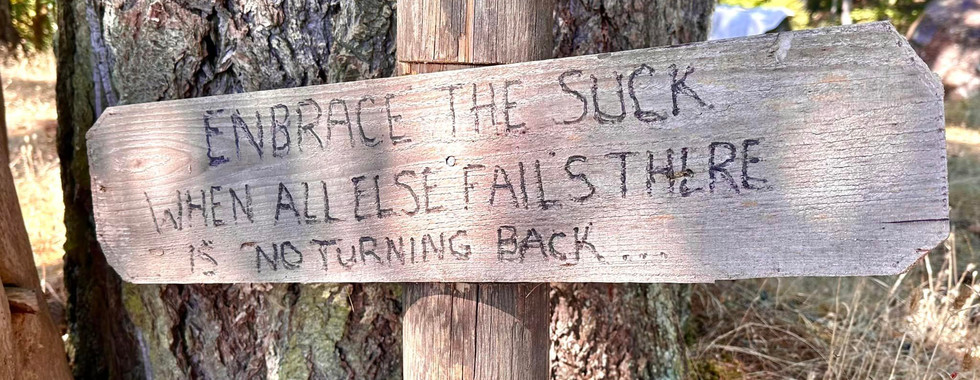Pacific Coast Expedition - The first 430 miles
- joshuaine
- Dec 21, 2023
- 6 min read
Updated: Feb 17
And here we are again! Reliving another bike/run expedition, this one along the beautiful and scenic Pacific Coast loosely following the Pacific Coast Bike Route. This blog post covers the 12 days we spent traveling through Washington, and touches on the physical/mental challenges, tough conditions, pretty views, and awesome people we encountered.

It was just before 6 AM on August 29, 2023. We were walking to the Vancouver Maritime Museum, the northernmost point of the Adventure Cycling Association's Pacific Coast route and the starting point of the trip. It was raining. It was 45 degrees. Shan hadn't taken his first step and we already had an issue. On our way to the start point, we realized Shan's passport was still at the hotel. Since he would most certainly need it to cross the border into the US later that day, I dashed back to retrieve it for him. I raced my bike to meet him just as he arrived at the starting point. In a steady rain, we did the "picture, kiss, see you later" routine, documenting the official start time, and he started running. I returned to the hotel to work and started my ride 5 hours later. It was still raining.

After 42.5 miles of running Shan crossed the Canadian-US border into Blaine, WA. This was the first time one of our run/bike trips had taken us over a border crossing and Shan's unconventional approach to the customs window, walking in line with the cars, made for an unforgettable moment. He had some stares and was met with a mix of impatience, disbelief, and awe by the customs officers. After I passed through the border several hours later, just 1 mile from our hotel, I got lost (I misunderstood the officer's easy directions...). My final mile turned into a rainy (it had not stopped raining all day...) 2+ miles zig-zag through neighborhoods, cursing and laughing at myself. Shan waited patiently for me to arrive with all of our gear. It was one of only a few wrong turns on this trip, but it wasn't the last time Shan had to wait for me to catch up at the end of the day.
Shan gets sick :(
Our initial plan for this expedition was to cover ~40 miles a day, which would have gotten us to Oregon in 10 days. But life on the road, especially on an expedition like this, is rarely without surprises. Our trip proceeded as planned until we reached Shelton, WA on Day 6. Shan had been feeling off that day and had no appetite. We assumed it was due to running a hilly 45 miles in nearly 90-degree temperatures, but we were wrong. He had come down with food poisoning. After a miserable sleepless night, I urged him to take a day off and he reluctantly agreed. I modified our plans to reduce our daily mileage for the next few days so his body could recover. This was our first significant delay, putting us 2 days behind schedule. Falling behind wasn't a big deal, we were prepared to make adjustments to our plans as needed. It turned out this would not be the last time we needed to be flexible - a few more surprises came our way! Just wait until we get to Oregon...oy vey.
Road hazards
The roads along the Pacific Coast were tough on our bodies (as expected), but they were also tough on my bike and trailer tires. As Pacific Coast cyclists already know, when logging trucks have tire blowouts they leave behind tiny splinters of metal. I learned this early in our trip and quickly added tweezers to my bike repair kit. This wasn't the only hazard, though. The roadsides were covered in thorny raspberry bushes and a plant called Tribulus terrestris, also known as Puncturevine or the more popular "goathead", which perfectly describes the appearance of these spiny burs that littered the roadsides. These plants were a recurring source of stress for me (and poor Shan who had to hear me complain repeatedly). On our 3000-mile East Coast Greenway Expedition in 2022, I had exactly 1 flat tire. This time around, I was faced with a lot of them. I had flat tires on Day 2 and again on Day 3. I don't know how many total flat tires I had during the trip, we lost count.
Restricted Roadways
During the first week of our trip, we came across roads, bridges, and tunnels that were not pedestrian-friendly. On Day 5 we crossed the Hood Canal floating bridge*1. We were initially worried about Shan crossing on foot since it wasn't clear whether pedestrians were permitted on the bridge. To be as safe and visible as possible, we decided to cross together with traffic, with Shan leading on foot and me following on the bike (something we've done before on other trips). The shoulder was very wide, and we crossed the 1.5-mile bridge without incident with Shan running as quickly as he could. As it turned out the bridge-crossing was less interesting than the protesters we passed holding "my body, my choice" signs, which surprisingly conveyed an anti-vaccine message.
On our last full day in Washington, we were on a 10-mile stretch of Route 4 which travels along the Columbia River. The road gave beautiful views but was also a high-stress road for us. I had the advantage of traveling faster (it was a flat stretch so I could manage 12+ mph at times) and I was more visible, but Shan was running facing traffic on a tiny shoulder with very little room. Several times he had to scramble over the guardrail to avoid oncoming tractor-trailers. It was a relief to make it through that section and relax at a cottage on the bank of the slough2 in Cathlamet.
The people
One thing that stands out the most when we do these long-distance expeditions - the people. Whether it's friends we meet up with - like Amio, April, and Bee who brought pizza and beer to our campsite at Deception Point - or WarmShowers*3 hosts that open their homes to us. We will always remember the hospitality. But some encounters are hard to forget for different reasons. From the beginning, it was clear that this expedition was going to be much harder than our last one. In addition to the logistical challenges (to be covered in another post), there were a lot of hills. We knew the elevation would slow us down, but I was surprised by how much it affected my mood and self-confidence. I was struggling from the beginning. One evening, as we chatted with people at a campground, they downplayed my role in our expedition by announcing "You've got the easy job". My cute little ego was bruised and I started feeling discouraged. But a few days later, I was slowly pedaling uphill into a town (really slow - barely-ride-in-a-straight-line slow) when I passed a guy standing at a bus stop. I glanced over at him for a second and he gave a little nod and said to me, "You got this." Those three little words "You. Got. This." completely lifted my mood. He didn't know where I was headed or how far I had come. He didn't know that I had started having dreams of my bike and trailer "having a little accident", forcing me to drive a support vehicle for Shan instead of towing our gear by bike. His words landed so nicely. Thank you, guy at the bus stop, for seeing me struggling, and for seeing that I needed the encouragement. I referred to those three little words multiple times over the next 50 days. I am eternally grateful!

We made it through Washington
Even though we had some hiccups, most of the miles in Washington were awesome. The views of the coastline were beautiful and we truly loved the quiet roads. We were able to relax on two ferry rides, one on our way to Port Townsend, where we saw orcas swimming along with us, and the other on a sunrise trip across the Columbia River from Cathlamet, WA to Westport, OR. After crossing the state border, we stopped for the night in Astoria, OR, where the movie Goonies was filmed. And yes, we watched the movie.
The Hood Canal Bridge is the longest floating bridge over a saltwater basin (1.5 miles). It carries State Route 104 across Hood Canal in Puget Sound and connects the Olympic and Kitsap Peninsulas.
What is a slough? Along the West Coast, sloughs are often named for the quiet, backwater parts of bays and are part of the estuary, where freshwater flows from creeks and runoff from land mix with salty ocean water transported by the tides. In Cathlamet, this slough was connected to the Columbia River where our WarmShowers hosts had retired to enjoy some spectacular bird-watching.
WarmShowers is a non-profit hospitality exchange service for people who are involved in bicycle touring. It's a gift economy platform, where hosts, who are often also cyclists, open their yards, homes, etc., to other cyclists to tent or use their guest rooms. - Big thanks to Mike and Rach for sharing their guest room and making us dinner in Port Townsend. We could have talked all night - they are cyclists who have crossed the country in every direction, lived on a sailboat, and much more. - Thank you also to Vicki and Jim, in Cathlamet, for sharing their guest cottage which was hand-built by Jim, and had everything we needed. We felt like we were on vacation.



















































Comments